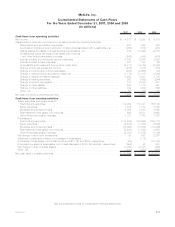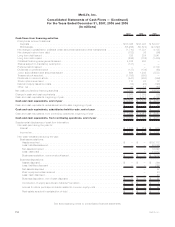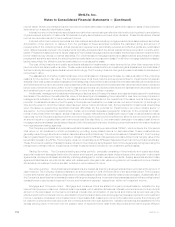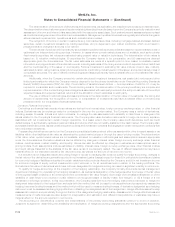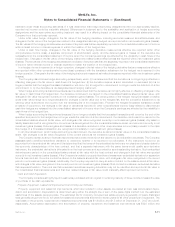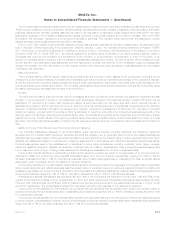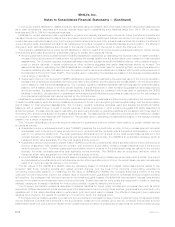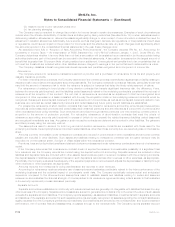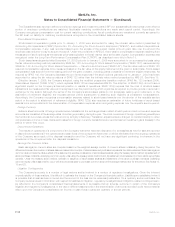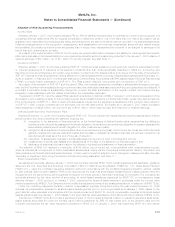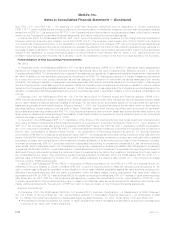MetLife 2007 Annual Report Download - page 111
Download and view the complete annual report
Please find page 111 of the 2007 MetLife annual report below. You can navigate through the pages in the report by either clicking on the pages listed below, or by using the keyword search tool below to find specific information within the annual report.from 1% to 17% for domestic business and 1% to 15% for international business, less expenses, mortality charges, and withdrawals; and
(iii) fair value adjustments relating to business combinations. Bank deposits are also included in policyholder account balances.
Other Policyholder Funds
Other policyholder funds include policy and contract claims, unearned revenue liabilities, premiums received in advance, policyholder
dividends due and unpaid, and policyholder dividends left on deposit.
The liability for policy and contract claims generally relates to incurred but not reported death, disability, long-term care and dental
claims as well as claims which have been reported but not yet settled. The liability for these claims is based on the Company’s estimated
ultimate cost of settling all claims. The Company derives estimates for the development of incurred but not reported claims principally from
actuarial analyses of historical patterns of claims and claims development for each line of business. The methods used to determine these
estimates are continually reviewed. Adjustments resulting from this continuous review process and differences between estimates and
payments for claims are recognized in policyholder benefits and claims expense in the period in which the estimates are changed or
payments are made.
The unearned revenue liability relates to universal life-type and investment-type products and represents policy charges for services to
be provided in future periods. The charges are deferred as unearned revenue and amortized using the product’s estimated gross profits
and margins, similar to DAC. Such amortization is recorded in universal life and investment-type product policy fees.
The Company accounts for the prepayment of premiums on its individual life, group life and health contracts as premium received in
advance and applies the cash received to premiums when due.
Also included in other policyholder funds are policyholder dividends due and unpaid on participating policies and policyholder dividends
left on deposit. Such liabilities are presented at amounts contractually due to policyholders.
Recognition of Insurance Revenue and Related Benefits
Premiums related to traditional life and annuity policies with life contingencies are recognized as revenues when due from policyholders.
Policyholder benefits and expenses are provided against such revenues to recognize profits over the estimated lives of the policies. When
premiums are due over a significantly shorter period than the period over which benefits are provided, any excess profit is deferred and
recognized into operations in a constant relationship to insurance in-force or, for annuities, the amount of expected future policy benefit
payments.
Premiums related to non-medical health and disability contracts are recognized on a pro rata basis over the applicable contract term.
Deposits related to universal life-type and investment-type products are credited to policyholder account balances. Revenues from
such contracts consist of amounts assessed against policyholder account balances for mortality, policy administration and surrender
charges and are recorded in universal life and investment-type product policy fees in the period in which services are provided. Amounts
that are charged to operations include interest credited and benefit claims incurred in excess of related policyholder account balances.
Premiums related to property and casualty contracts are recognized as revenue on a pro rata basis over the applicable contract term.
Unearned premiums, representing the portion of premium written relating to the unexpired coverage, are included in future policy benefits.
Premiums, policy fees, policyholder benefits and expenses are presented net of reinsurance.
Other Revenues
Other revenues include advisory fees, broker-dealer commissions and fees, and administrative service fees. Such fees and com-
missions are recognized in the period in which services are performed. Other revenues also include changes in account value relating to
corporate-owned life insurance (“COLI”). Under certain COLI contracts, if the Company reports certain unlikely adverse results in its
consolidated financial statements, withdrawals would not be immediately available and would be subject to market value adjustment, which
could result in a reduction of the account value.
Policyholder Dividends
Policyholder dividends are approved annually by the insurance subsidiaries’ boards of directors. The aggregate amount of policyholder
dividends is related to actual interest, mortality, morbidity and expense experience for the year, as well as management’s judgment as to
the appropriate level of statutory surplus to be retained by the insurance subsidiaries.
Income Taxes
The Holding Company and its includable life insurance and non-life insurance subsidiaries file a consolidated U.S. federal income tax
return in accordance with the provisions of the Internal Revenue Code of 1986, as amended (the “Code”). Non-includable subsidiaries file
either separate individual corporate tax returns or separate consolidated tax returns.
The Company’s accounting for income taxes represents management’s best estimate of various events and transactions.
Deferred tax assets and liabilities resulting from temporary differences between the financial reporting and tax bases of assets and
liabilities are measured at the balance sheet date using enacted tax rates expected to apply to taxable income in the years the temporary
differences are expected to reverse.
The realization of deferred tax assets depends upon the existence of sufficient taxable income within the carryback or carryforward
periods under the tax law in the applicable tax jurisdiction. Valuation allowances are established when management determines, based on
available information, that it is more likely than not that deferred income tax assets will not be realized. Significant judgment is required in
determining whether valuation allowances should be established as well as the amount of such allowances. When making such
determination, consideration is given to, among other things, the following:
(i) future taxable income exclusive of reversing temporary differences and carryforwards;
(ii) future reversals of existing taxable temporary differences;
F-15MetLife, Inc.
MetLife, Inc.
Notes to Consolidated Financial Statements — (Continued)


